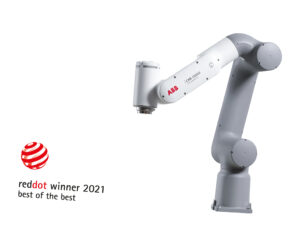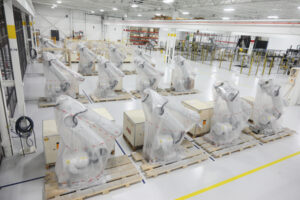 ABB Robotics & Discrete Automation – part of the global giant ABB Group, which also specializes in Electrification, Process Automation, and Motion – has its U.S. headquarters in Auburn Hills, Michigan, where it employs some 450 people.
ABB Robotics & Discrete Automation – part of the global giant ABB Group, which also specializes in Electrification, Process Automation, and Motion – has its U.S. headquarters in Auburn Hills, Michigan, where it employs some 450 people.
In May 2015, ABB began producing robots in the United States, making it the first global industrial robotics company to fully commit and invest in a North American robotics manufacturing footprint. This has allowed ABB’s North American operations to offer short lead times to its customers in the U.S., Mexico, and Canada.
According to Joe Chudy, general manager of the Robotics Division, who has spent 36 years with the company, ABB approaches the industrial market through a series of dedicated business lines. They include Automotive OEMs, Tier 1 Automotive Suppliers, General Industry, Consumer Segment & Service Robotics, and Machine Automation, which designs complete solutions for machine and factory automation through ABB’s B&R Automation unit.
“Our customer outreach involves a dedicated salesforce, along with what we refer to as “value providers,” which is our term for system integrators and full service distributors. We also sell direct, but 65 percent of our sales are channeled through our value providers,” he says.
Known for launching the IRB-6 – the world’s first all-electric, microprocessor-controlled, commercially available industrial robot – in 1974, technological advances have continued to be introduced at a whirlwind pace.
ABB recently expanded its collaborative robot portfolio with the new GoF and SWIFTI cobot families, offering higher payloads and speeds to complement YuMi and Single Arm YuMi in ABB’s cobot lineup. These stronger, faster and more capable cobots will accelerate the company’s expansion in high-growth segments including electronics, health care, consumer goods, logistics and food and beverage, among others, meeting the growing demand for automation across multiple industries.
 In April GoFa was awarded the prestigious Red Dot Best of the Best design award in recognition of its unique design concept to make the new robot more approachable to users with limited robot experience.
In April GoFa was awarded the prestigious Red Dot Best of the Best design award in recognition of its unique design concept to make the new robot more approachable to users with limited robot experience.
Product delivery lead times easily beat industry averages, even when customization is required, thanks to the robotic arm’s modular design. Arms can be stocked with a wide variety of options and additions for customers to choose from. It’s a common task for ABB Robotics to customize its arms to meet its customer’s exact specifications.
The R&D leading to these and thousands of additional advancements are achieved via a team of ABB experts located around the world. In the U.S., there are facilities found in San Jose, California, and in Fort Collins, Colorado. Other sites include Sweden, Germany, and China, among others. This strategy provides input from “the best people in the world,” Chudy says, “and it gives us the broad perspective we need to understand and anticipate global trends.”
 One recent mega-trend that ABB has identified is construction, where a shortage of skilled labor has led to a crisis. Robotics provides a solution to this dilemma, since robots can be equipped to tackle tasks such as building trusses, floors, wall, ceilings, and a long list of other operations that streamline and improve construction operations. “We’ve seem 20-30 percent growth in the use of robotics in the construction sector, and I expect that to increase significantly over the next few years” Chudy says.
One recent mega-trend that ABB has identified is construction, where a shortage of skilled labor has led to a crisis. Robotics provides a solution to this dilemma, since robots can be equipped to tackle tasks such as building trusses, floors, wall, ceilings, and a long list of other operations that streamline and improve construction operations. “We’ve seem 20-30 percent growth in the use of robotics in the construction sector, and I expect that to increase significantly over the next few years” Chudy says.
“New challenges and opportunities are constantly crossing our radar screen, and it takes a sharp eye to keep track of them all and make the right determination in terms of whether or not it’s a viable direction to pursue,” he says. “But one thing I can tell you for certain is that people are becoming increasingly hungry for automation.”


















